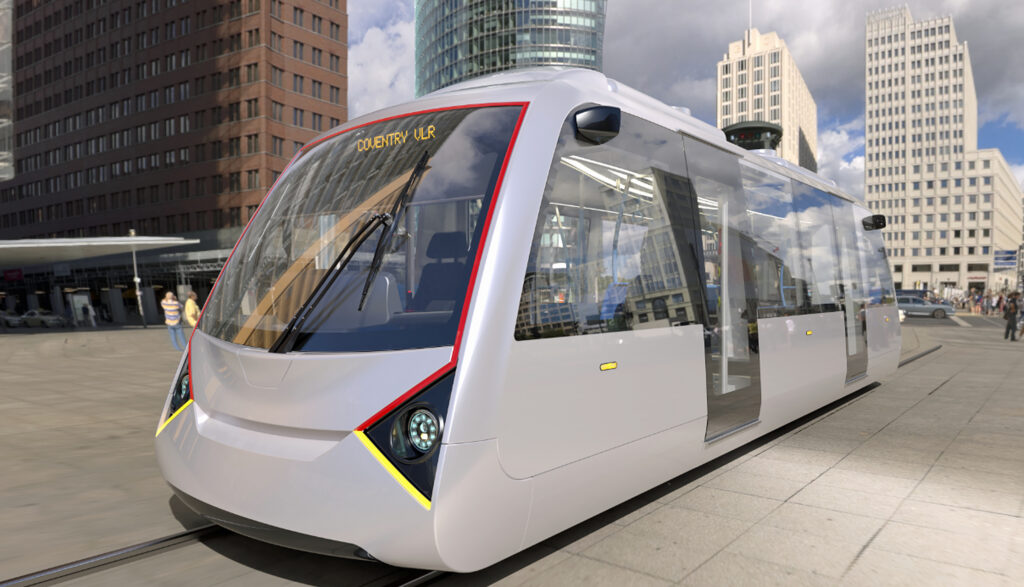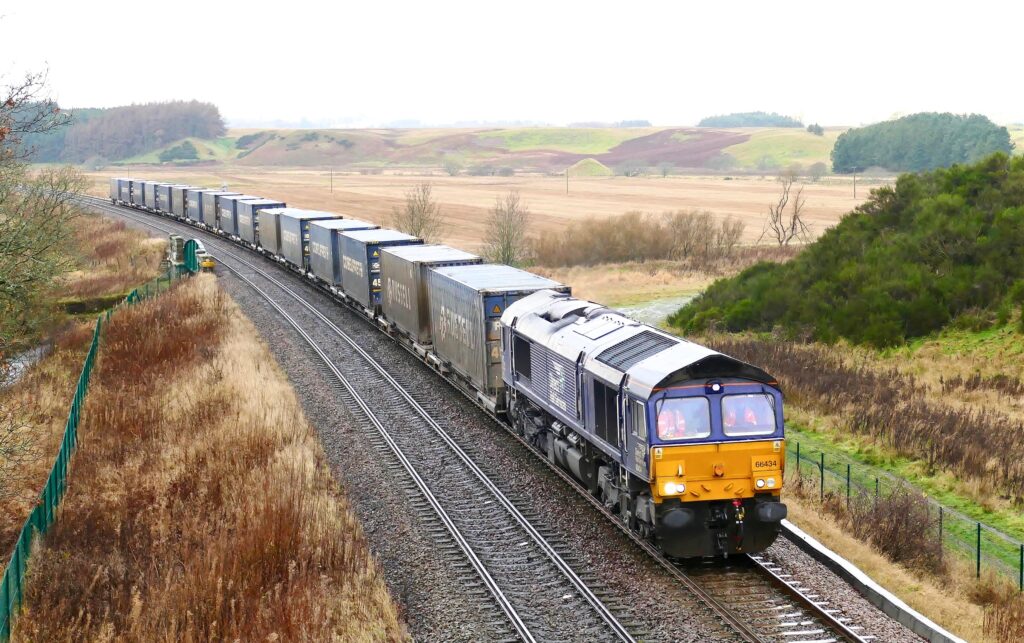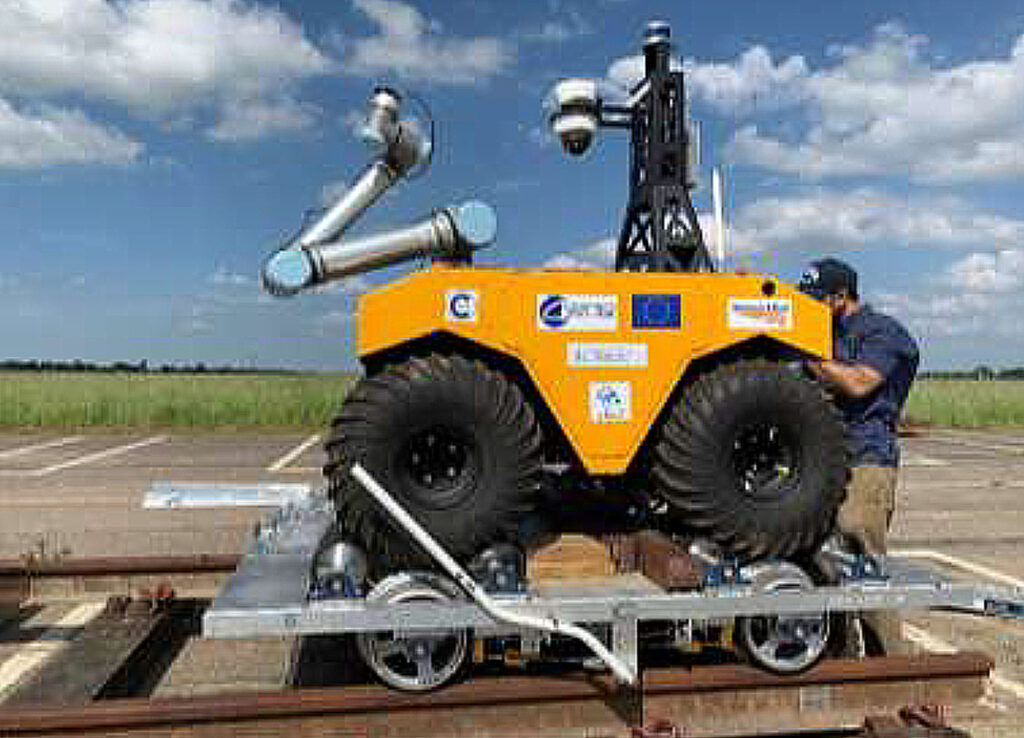The National Robotarium at Edinburgh’s Heriot-Watt University was a particularly appropriate venue for the Railway Industry Association (RIA)’s latest Unlocking Innovation event for which the theme was Track and Train. This was introduced by Milda Manomaityte who explained how RIA’s Unlocking Innovation programme aims to promote innovations within the UK rail industry and bring businesses together to create new opportunities to innovate. Bringing 100 people from different organisations to hear 16 presentations and tour the University’s Robotarium and Heavy Structures laboratory was certainly a good way of promoting these aims.
Heriot-Watt University
The University’s associate principal for impact, Professor Marc Desmulliez advised that Heriot-Watt University was founded in 1821 and now specialises in engineering, business, and science. Its graduate apprenticeship scheme offers work-based academic learning in partnership with 250 businesses. The University has also worked with InnovateUK to create Knowledge Transfer Partnerships supporting 84 businesses. Its collaborative R&D work includes that with Celestia Technologies to develop antenna technologies for high-speed data acquisition.
Heriot-Watt has been offering online degrees since 2003 and now has 11,000 students from over 160 countries. It has campuses in Dubai and Malaysia and its new GRID (global research, innovation and discovery) provides a globally networked space for global collaborative working between academic disciples and industry partners. This is supporting global research on robotics and AI, earth and marine sciences, health & care engineering, and net zero energy transition.
It is also part of the UK Rail Research and Innovation Network (UKRRIN)’s centre of excellence in infrastructure.
The Robotarium

The National Robotarium’s CEO Stewart Miller, advised that this 4,000 sq. metre facility opened in September after construction started in March 2021. Its £22 million cost was largely funded by the Edinburgh and South East Scotland City Deal with the aim of establishing the region as Europe’s data capital.
It is the home to world-leading Artificial Intelligence (AI) and robotic experts from Heriot-Watt University and the University of Edinburgh whose focus is the development and testing of robotics and associated AI solutions across three distinct areas; robotics and autonomous systems, human and robot interaction, and high precision manufacturing. Stewart advised that the aim of this research is to keep people safe and healthy and make them more productive as well as developing talent and shaping the future.
He advised that the Robotarium aims to help companies reduce time, cost, and risk of introducing robotics by demonstrating proof of concept. It can also provide SMEs from across the UK with a gateway to the UK Robotics sector. He noted that the use of robots for manufacturing was now well established and felt that robotics offered particular benefits for the healthcare, hospitality, agriculture, and construction sectors. The afternoon tour of the Robotarium demonstrated some of its robots in its laboratories and outdoor test area. This included the Boston Dynamics robot ‘dog’ which had an uncanny lifelike movement.
TfW Lab
When Transport for Wales (TfW) was established in 2018, the aim was to significantly enhance the customer experience to encourage modal shift from car to public transport. As well as a large programme of investment in infrastructure, stations, and new trains, it was recognised that TfW needs to utilise the best emerging technologies.
In his presentation, TfW’s innovation manager, Michael Davies explained how the TfW Lab works with early-to-mid-stage start-ups. Since 2019, the Lab has completed four cohorts of a total of 30 companies selected from 300 applicants. These companies were asked to provide solutions for challenge statements. To do so they are supported by a 12-week accelerator programme which includes access to TfW personnel, workshops, and mentoring before pitching to an expert panel at a demo day from which a cohort winner is selected. The winners of the four cohorts were:
- Joint winners were Briteyellow which digitises indoor spaces to accurately locate, track, and guide customers and staff, and PassageWay which provides smart digital signs with real-time passenger information.
- Spatial Cortex which has developed wearable technology to reduce the risks from manual handling tasks.
- RoboK which offers a battery/solar powered system to monitor use and behaviours at footpath level crossings.
- Cufflink, a security and regulatory compliance company which manages the distribution of sensitive data footpath.
From the four cohorts, there are now 12 ongoing projects for which contracts to the value of £500,000 have been awarded. The TfW Labs have helped these companies raise a total of £1.6 million funding and investment. An invitation to participate in a fifth cohort closed at the end of June.
Coventry’s VLR
In response to the need for an affordable light rail system, Coventry City Council has been promoting the development of a Very Light Rail (VLR) network as reported in issue 197 (July – August 2022). One reason for this is that the city has significant exceedances of air pollution limits and that, unlike buses, light rail does not have the non-tailpipe emissions from brake pads and tyres.


Angus Brummitt-Brown, Coventry’s senior VLR project manager for Coventry City Council explained the background to this project for which, in January, the West Midlands Combined Authority agreed the first instalment of an expected £72 million investment. As a result, the Coventry VLR system will be showcased between the railway station and city centre in a few years’ time.
He explained why the VLR is expected to cost around £10 million/km. This compares with £56 million/km for the recently opened Edinburgh tram extension to Newhaven. This low cost is largely due to a novel track form which significantly reduces the number of infrastructure diversions required and simpler battery powered vehicles that don’t require overhead catenary.
Angus noted that pioneering this novel form of transport was not without its challenges. Funding is difficult as the VLR project has significant uncertainties, though these will be alleviated by thorough testing the Very Light Rail National Innovation Centre (VLRNIC) in nearby Dudley. Approving something that “does not fit into a box” is a challenge for which the VLRNIC will also be helpful.
Compliance with the public contracts regulations for the procurement of a unique product and its associated R&D activity is also problematic.
Scottish rail freight
The presentation given by Martin Bignell, Scottish and Northern Representative, Rail Freight Group (RFG) concerned the way rail freight works in Scotland. In respect of innovation, this is more about a different way of doing things in Scotland rather than introducing new technology.
In Scotland there are six competing freight operators who run about 300 services a week. Of this, 14% is internal Scottish traffic, 35% is traffic to Scotland, and 52% is from Scotland. Of the Anglo-Scottish trains, about 80% run on the West Coast Main Line. Eighty percent of Scottish rail freight is intermodal and construction traffic.
As the RFG representative for Scotland and Northern England, Martin felt that the ‘Scotland’s Railway’ approach had been particularly successful and more collaborative. He considered that the reasons for this included:
- The Scottish High Level Output Statement (HLOS) brings clarity (e.g., it includes specifics such as gauging, power supplies, electrification, and a specific 8.7% CP7 freight target that are not mentioned in the HLOS for England and Wales published by the DfT).
- Holistic planning of infrastructure and operational interventions.
- Enhanced reporting of freight metrics.
- A quarterly Scottish freight joint board that provides collaborative governance which puts the industry at the centre of planning and investment decisions to bring transparency, shares best practice, and highlights specific requirements e.g., review of section running times and digitalisation of freight train load book.

He felt that, with a clear commitment from the Scottish Government, this approach showed that a ‘guiding mind’ for track and train doesn’t have to mean vertical integration of infrastructure and operator. Instead, the objective should be about behaviours and enabling a mixed-use railway to work in accordance with its customers’ requirements.
Martin felt that it was essential that rail freight has the flexibility to respond to changing demand such as that from new hubs. Yet rail infrastructure has very, very long-term planning horizons. Hence, freight operators need confidence that there is sufficient capacity for them to grow in the medium and short term. He concluded by noting that, if there is to be modal shift, there must be space for it to grow into.
Rail maintenance robots
The development of a robotic Railway Inspection and Repair System (RIRS) was the subject of a presentation by Miftahur Rahman, a PhD student of Cranfield University. His project is the development of an autonomous vehicle to undertake track inspection and repairs. He noted that this had the potential to automate hazardous on-track tasks.
RIRS uses a Warthog ground vehicle robot with an adaptive trolley that enables it to travel on and off-track. It has a robotic manipulator arm and multiple onboard sensors including LIDAR, real time kinematic (RTK) GPS camera, multiple types of cameras, wheel odometry and an inertial measurement unit (IMU) which measures the three degrees of linear acceleration as well as the three rotational rate components. The vehicle is controlled by Kinetic Kame robotics operating software which uses Gazebo development libraries to provide advanced 3D graphics and simulate dynamic loading.

Miftahur explained that the vehicle can determine its position from RTK GPS, distance travelled, and recognising known trackside objects. He explained how the limitations of a forward-facing camera are overcome by having the manipulator arm take multiple images from different positions to provide a data rich 3D model of an object which can be compared with 3D models of other similar objects to detect any anomalies. When working off-track, the vehicle can optimise its route to avoid obstacles and it has object detectors to avoid collisions when working on track.
The prototype has been tested on track when it detected simulated rail damage and sent accurate information about its location. Yet various challenges remain. Miftahur advised these include track access, communications, refining location awareness, power, task verification, and cybersecurity. When these have been addressed, the RIRS vehicle is likely to be the first autonomous prototype robotic rail maintenance demonstrator. It will be interesting to see when such robots first see practical use.
Elevator pitches
A feature of the RIA Unlocking Innovation events is their elevator pitches when presenters are given a few minutes to convince those present of the benefits of their innovation. Of the nine pitches, only one featured innovative hardware whilst most of the others used AI to improve asset management or provide meaningful customer information.
Helping visually impaired people navigate the UK public transport network was the focus of a presentation by GoMedia’s Sven Koster. Its app does this by reading NaviLens codes which, unlike QR codes, can be read from up to 20 metres without the user knowing where they are placed. This has been developed in collaboration with the Royal National Institute of Blind People and is now being piloted at London Euston.
Navilens code
Rob Franklin described how his company, Jnction, had worked with rail companies to provide tools customised for their needs using AI. Its ‘Aubin’ wayfinding app is designed to assist the autistic community by providing a journey planner that avoids aspects that cause stress. It is soon to be trialled at Bristol Temple Meads station.
The founder of WorkfromHub, Neal Byers, believes there is a need for private working spaces in easy-to-access locations. To satisfy this demand, his company is setting up a network of working hubs which can be booked using an app.

The benefits of AI for asset management were illustrated by Tim Flowers who explained how his company, KONUX offers predictive maintenance, network usage, and traffic monitoring and planning solutions for railway infrastructure management. In particular, KONUX Switch can increase the life of a rail switch and monitor the traffic over it.
AI also offers improved station safety as Duncan Kennon of Createc illustrated by describing how ‘Situate’ offers real-time crowd monitoring using long range LIDAR sensors. As this doesn’t use cameras, there are no privacy issues. Crosstech’s Hubble application does use a camera, specifically forward-facing video which is analysed by AI to identify and prioritise asset faults as Haydon Bartlett-Tasker described.
Milo Lloyd of ‘The Formal Route’ described how the SafeCap toolset has been developed to provide a fully automated verification signalling interlocking data. It has Network Rail approval and, over the past three years, has been successfully used to verify 60 interlockings developed by different suppliers and identified some safety issues.
In contrast to the other pitches, Stuart Jackman of Jackweld pitched innovative hardware that had been developed to address Network Rail rail welding process challenge statement. This shows that there are around 40,000 aluminothermic welds a year with a 2% rejection rate. Jackweld’s solution is a vibrationless orbital friction welding system which moves a thin steel disc clamped between the rail faces. This provides a solid-state welding process with no melting of the parent metal, and so retains the parent metal’s structure and does not result in fatigue failure initiators. It also has a much-reduced heat affected zone and uses less than 25% of the energy of thermic welding. For these reasons, orbital friction is more reliable and cost effective than thermal welding as well as being ideal for advanced metal alloys. Stuart advised that the system is currently awaiting a Network Rail trial.
Heavy structures lab
Prior to visiting the University’s heavy structures laboratory, Professor Omar Laghrouche explained how its work has supported the rail industry. This included the 2015 report ‘Geodynamics of train-track-soil under high-speed train loading’ which was undertaken to address concerns raised during the HS2 Bill process. At the time, it suggested that high-speed trains may be derailed due to ground instability due to their travelling close to the wave propagation velocity of the supporting track-ground system.
In collaboration with Balfour Beatty, the University has also developed XiTRACK polyurethane ballast reinforcement which has been used in heavily trafficked locations such as Clapham Junction. Another example is accelerated full-scale testing of railway slab and ballasted tracks on the GRAFT rig which can simulate a year’s loading in a day. The Geo-pavement and Railways Accelerated Fatigue Testing facility (GRAFT) is one of only two academic facilities of its kind in the UK. It has a hydraulic capacity of 200 tonnes (150 tonnes cyclically) which enables accelerated testing of existing and new railway products in realistic railway conditions.


Whilst visiting the heavy structures lab, those present saw the GRAFT rig about to be used to test novel composite sleepers. Also on display was 3D printing of free form structural members and synthetic bricks recycled from construction waste.
As always, RIA’s innovation events are thought provoking. This one highlighted the opportunities and challenges of AI and robotics for which there are currently few general use applications. This is perhaps not surprising as, for example, the Boston Dynamics robot dog went on sale to the public in 2021 for $75,000. Whilst few can now afford such robots, production at scale could soon see their widespread business and domestic use in the same way that initially expensive mobile phones are now ubiquitous.
Yet the event also showed that railway engineering is fundamentally about heavy engineering to control the large forces generated as, for example, a 450-tonne train is supported and guided by rails at 200 km/hr. This is only possible as a result of the research done at universities such as Heriot-Watt.

